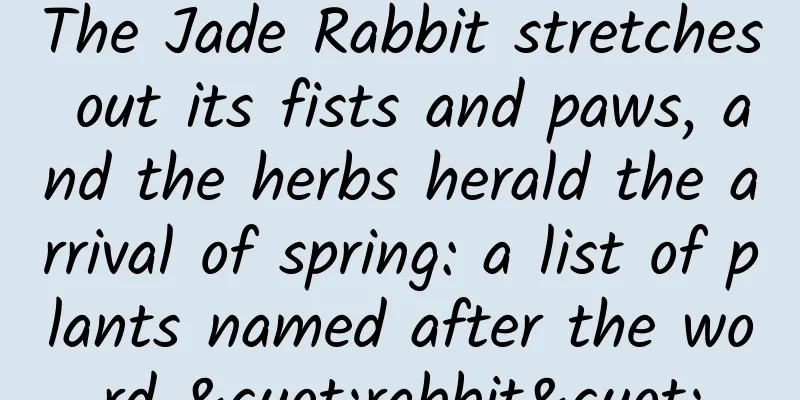The Jade Rabbit stretches out its fists and paws, and the herbs herald the arrival of spring: a list of plants named after the word "rabbit"

|
The New Year's bell has rung, and the four seasons are about to start a new cycle. Sending off the golden tiger in the winter snow and welcoming the jade rabbit in the spring sun, the zodiac rotates, giving the new year a new symbol. The Year of the Rabbit is here, and the knowledge about rabbits is also increasing! For a long time, we have known that rabbits are cute little animals, but how can the "magic" of nature be limited to this? In nature, there are many flowers and plants named after "rabbits". What is the connection between these flowers and plants and "rabbits"? Today, we will count the plants named after "rabbits". Part 1 Snow Hare (Saussurea Subgen. Eriocoryne) ——Appreciating the beauty of the lonely mountain on the top of the cloud Plants of the Saussurea subgenus of the Asteraceae family are mainly distributed in high-altitude areas such as the Qinghai-Tibet Plateau and its surrounding mountains, and are commonly found in habitats such as alpine rocky beaches. These places have extremely cold climates, and if you want to survive there, you must overcome the low temperature problem. To keep warm and avoid frost damage, the snow rabbit is usually covered with dense cotton wool. At the same time, its plants are generally short and sturdy, just like a curled up rabbit. Its flowers are at the top of the plant and are often surrounded by furry bracts. Jellyfish Snow Rabbit Saussurea medusa (Photo source: PPBC/Song Ding) Saussurea quercifolia (Photo source: Wei Zhourui) Snow rabbits are one of the common species in alpine scree. However, with the prosperity of the tourism industry in recent years, people have dug up a large number of snow rabbits and sold them to tourists as specialties and medicinal herbs such as "snow lotus", causing the slow-growing snow rabbits to disappear in large numbers. Today, Saussurea gossipiphora, Saussurea laniceps and Saussurea medusa have been listed as national Class II protected plants and are strictly protected . If you have the opportunity to step into the snowy area, you can only watch these magical creatures from a distance and not play with them, so that their beauty can be preserved on the plateau to the greatest extent. Anchor was investigated for illegally mining jellyfish and snow rabbits (Image source: Tencent Video) Part 2 Utricularia sandersonii ——The hunter also showed his charming face The small white rabbit bladderwort is a plant of the genus Bladderwort in the family Lauriculariaceae. It is native to South Africa and is a small terrestrial bladderwort that lives in humid environments. Its corolla is in the shape of two lips, and the upper lip is divided into two lobes, just like the two ears of a little rabbit, which is very cute. The little white rabbit bladderwort is one of the most popular carnivorous plants. It is relatively easy to survive and bloom, and can be grown as a small potted plant for viewing. Utricularia sandersonii (Photo source: Wei Zhourui) However, the bladderwort, which looks cute and small on the surface, is actually a real "hunter" . Its insect sac grows on the leaf organs, creeping branches and adventitious roots, and is flat and sac-shaped, like a small pocket. The insect sac is usually in a contracted state, but when it detects small zooplankton, it will suddenly expand and suck the small animal into the sac by negative pressure, digest the sucked zooplankton, and then absorb the mineral elements in it. There is a difference between insect hunting and animal hunting. Insects are not obtained by insects for organic nutrition and energy, but animals are used as a supplementary source of inorganic nutrients. Therefore, insectivorous plants usually live in places with clean water, low salt content, and lack of inorganic nutrients. When potting, the salt content of water should also be strictly controlled. Utricularia vulgaris and its insect trap (Photo source: Wei Zhourui) Part 3 Cymbidium lancifolium ——The fragrant jade face is hidden in the empty valley The rabbit ear orchid is a plant of the genus Orchidaceae, distributed from the Himalayas to Southeast Asia, southern Japan and New Guinea. This orchid gets its name from its slender, drooping white calyx that resembles rabbit ears. Compared with cymbidium orchids and spring orchids, its leaves are wider and rounder, giving it a different style. Rabbit ear orchid is also a common ornamental orchid, and many varieties have been cultivated. Although rabbit ear orchid is not included in the list of national key protected wild plants (2021 edition), other species of the same genus are protected plants, and it is difficult for non-professionals to distinguish them. Therefore, if you like rabbit ear orchid, remember to choose cultivated varieties. Cymbidium lancifolium (Photo source: PPBC/Chen Binghua) Part 4 Ainsliaea spp. ——He has a miraculous prescription to help people The genus Lepidium is a herbaceous plant of the Asteraceae family, mainly distributed in the Yangtze River Basin and the provinces to the south. Similar to Lepidium, most of them also have rosette-shaped basal leaves, which are thick when young. When they grow up, they will stretch out large and branched inflorescences and bloom small chrysanthemums. The glabra of this genus can be used as medicine, namely the traditional Chinese medicine "Tu'erfeng", which has the effects of moistening the lungs, relieving cough, and healing bones and wounds. Ainsliaea fragrans seedlings (Photo source: Wei Zhourui) Ainsliaea glabra (Photo source: PPBC/Zhou Jianjun) Part.5 Cyclamen persicum ——Bright red and purple bring blessings Cyclamen is a perennial flower of the Primulaceae family, native to West Asia. Its petals are long, reflexed and drooping, resembling rabbit ears, so it is also called "rabbit ear flower". Cyclamen has large and colorful flowers and often has spots on its leaves. It has a high ornamental value and is now widely cultivated. It has various colors and double petals. During the Spring Festival, it can often be seen in shops and parks, adding to the festive atmosphere. Although cyclamen is a frequent visitor to the New Year flower market, it is not cold-resistant and needs to overwinter in a greenhouse in the north. Cyclamen persicum in different colors (Photo source: Wei Zhourui) Part 6 Leontopodium junpeianum ——Wearing a white coat and holding flowers Long-leaf edelweiss is a plant of the genus edelweiss in the Asteraceae family, widely distributed in the mountains of North, Northwest and Southwest China. This plant is also known as "rabbit's ear grass", which, as the name suggests, refers to the slender "petals" that are thickly covered with a "quilted jacket". However, this part is not a real petal, but a bract that surrounds the head inflorescence group, which is actually a special leaf. Like many plateau plants, the genus Leontopodium is covered with white soft hairs, which is an adaptation to the cold environment. The petal-like bracts are to increase the visual display of the flowers, making the originally tiny flowers look more conspicuous, attracting pollinating insects to visit, and improving the success rate of reproduction. In newer classifications, L. junpeianum has been treated as a synonym of L. conglobatum. Leontopodium junpeianum (Photo source: PPBC/Zhu Xinxin) Part 7 Lagochilus spp. ——The little rabbit is hiding in the desert The genus Harelip belongs to the Lamiaceae family and has a two-lipped corolla, of which the upper lip is usually two-lobed or has four teeth, and the lower lip is three-lobed. The petals are shaped like a rabbit's "three-lobed mouth, two-parted", and the stamens in the center of the flower are more like the two big front teeth of a rabbit, so it is figuratively called Harelip. These plants are herbs or small shrubs, native to northwest my country and Central Asia, and often grow in arid areas. In order to better absorb and retain water and defend against herbivores, they, like many desert plants, generally have thick and strong rhizomes and sharp and thorny leaves. Lagochilus bungei (Photo source: PPBC/Chen Yousheng) Part 8 Lagurus ovatus ——The fluffy rabbit tail comes from the west Rabbittail grass is a plant of the genus Rabbittail grass in the Poaceae family. It is native to the area near the Mediterranean and is now introduced to all parts of the world as an ornamental plant. The flower spikes of rabbit's tail grass are somewhat similar to those of foxtail grass, but are shorter and thicker, teardrop-shaped, and covered with dense and long white hairs, which are very similar to the short tail of a rabbit, hence the name. Rabbit's tail grass is an excellent material for dried and cut flowers. It can also be used in gardens and flower borders. Dwarf varieties can also be potted for viewing. Lagurus ovatus (Photo source: Wei Zhourui) Part 9 Pseudolysimachion longifolium ——One ear of blue flowers adorns hundreds of villages The rabbit's tail plant is a plant of the Plantaginaceae family, distributed in the northern part of Eurasia. It was once placed in the genus Veronica of the Scrophulariaceae family, also known as the long-tailed Veronica. This plant has long and dense spikes of blue-purple inflorescence, has a high ornamental value, and is currently cultivated in some parks. Pseudolysimachion longifolium (Photo source: Wei Zhourui) Part 10 Syneilesis spp. ——The little green umbrella emerges from the ground The genus Cyperus belongs to the Asteraceae family and is a perennial herb distributed in East Asia. Its appearance does not seem to have anything to do with "rabbit". The "rabbit" in its name may mean that wild rabbits like to eat it, but it is unknown whether this is true. However, the description of "umbrella" is very vivid. The basal leaves of the cycad are shield-shaped, palmately divided, with long handles, just like a bunch of small umbrellas. When young, they are covered with white soft hairs, which is very cute. Its peduncle is very long, much higher than the leaves, the inflorescence head is very small, and the florets are only tubular, looking like there are only stamens without petals, and they grow near the top of the peduncle. Leaves of Syneilesis aconitifolia (Photo source: Wei Zhourui) Flowers of the southern umbrella Syneilesis australis (Photo source: Wei Zhourui) In addition to the plants named after "rabbit", there are also some plants whose names contain the word "tu" (a Chinese word for rabbit) with the same pronunciation but different characters. In ancient Chinese, "tu" (a Chinese word for rabbit) is sometimes used as a synonym for "rabbit", such as "seeing tu and looking back at the dog, it is not too late" in "Strategies of the Warring States". Of course, the word also has other meanings. Plants named with "tu" include Eranthis stellata, Cuscuta spp., etc. Part 11 Eranthis stellata ——The White-Faced Fairy Hides in the Deep Forest Doren is a small perennial herb of the genus Doren in the Ranunculaceae family. It is mainly distributed in the Northeast and grows in the shade of trees. This small wild flower blooms in early spring, with a slender scape and a small white flower on top supported by a round of leaf-like bracts, which is very elegant and lovely. Its beautiful white "petals" are actually sepals. Eranthis stellata (Photo source: PPBC/Zhou Yao) Part 12 Cuscuta spp. ——Golden silk surrounds the hearts of the poor farmers Cuscuta belongs to the Convolvulaceae family. It is a type of parasitic plant that is widely distributed in warm temperate zones around the world, mainly in America. This type of plant is a vine with no roots or leaves. It neither absorbs nutrients from the soil nor carries out photosynthesis. Instead, it attaches itself to the host and lives a "free-for-nothing" life. Cuscuta has strong growth and reproduction capabilities, which can cause harm to the host. For example, parasitism on crops often causes a reduction in yield, so it is considered a pest in agriculture. The ancient poem "Dodder Attached to the Female Wisteria" that describes love is actually a parasitic state of Cuscuta in reality. Cuscuta japonica, Cuscuta europaea, Cuscuta campestris and others have been listed as invasive alien plants, and their spread needs to be prevented and controlled. Cuscuta campestris (Photo source: Wei Zhourui) Conclusion The cute image of rabbits has been deeply rooted in people's hearts. The long ears, short tail and furry body are the most impressive. Therefore, most plants named "rabbit" also have related shapes, and the "rabbits" in these plants also have their own characteristics. References: [1] Flora of China Editorial Committee, Chinese Academy of Sciences. Flora of China[M]. Beijing: Science Press. 2004. [2]Plants of the World Online https://powo.science.kew.org/ [3] China Medical Information Query Platform. https://www.dayi.org.cn/ Produced by: Science Popularization China Author: Wei Zhourui (Institute of Botany, Chinese Academy of Sciences) Reviewer: Lai Yangjun (Institute of Botany, Chinese Academy of Sciences) Editor: Ying Yike Producer: China Science Expo The article only represents the author's views and does not represent the position of China Science Expo This article was first published in China Science Expo (kepubolan) Please indicate the source of the public account when reprinting Please indicate the source of the reprint. Reprinting without authorization is prohibited. For reprint authorization, cooperation, and submission matters, please contact [email protected] |
>>: I'm so greedy. Is it possible to smell the aroma while watching food videos?
Recommend
How to place advertisements on Zhihu? Give you a promotion secret!
Let me share it with you today! During the delive...
Cognition and scale—how do operations intervene in products?
Products and operations may indeed conflict over ...
Video Network Promotion Methodology
According to iResearch mUserTracker data, in 2016...
Changsha tea tasting tea arrangement
Content: Changsha new tea arrangement appointment...
Useful Information | The most comprehensive guide to short video distribution on Douyin, Kuaishou, etc.!
In the Internet age, short videos are king. Short...
How does MissFresh conduct private domain operations?
In the past, when we went to the supermarket to b...
Common performance optimization techniques in iOS development
What are the main causes of performance issues? T...
What is the Juliang Qianchuan advertising platform? How to advertise on TikTok?
Douyin began to enter the e-commerce field in an ...
Yang Kai's half-year video course on institutional trading strategy improvement class from June to December 2021
Yang Kai's half-year video course on institut...
Back pain and fractures, are they caused by "crab disease"? This blood indicator is a "super detective" that can find the culprit!
Multiple myeloma, commonly known as "crab di...
Pinduoduo: Building a growth model with the North Star indicator
The North Star refers to the absolute core indica...
Summary of rumors about the next-generation iPhone: Big screen/ultra-thin/more powerful performance
Apple iPhone 6 has always been highly exposed, and...
What kind of "worm" was the Yunnanworm 518 million years ago? The top ten advances in Chinese paleontology in 2022 are released
When, where, and how did the key evolutionary lin...
The product logic behind the epidemic topics of Toutiao, WeChat, and Alipay
In January 2020, at the beginning of the Chinese ...
Zi'an Real Estate Financial Quotient Leasing Practice Training Camp (Third Session) Course
You must be familiar with the IP Zi'an. He in...









